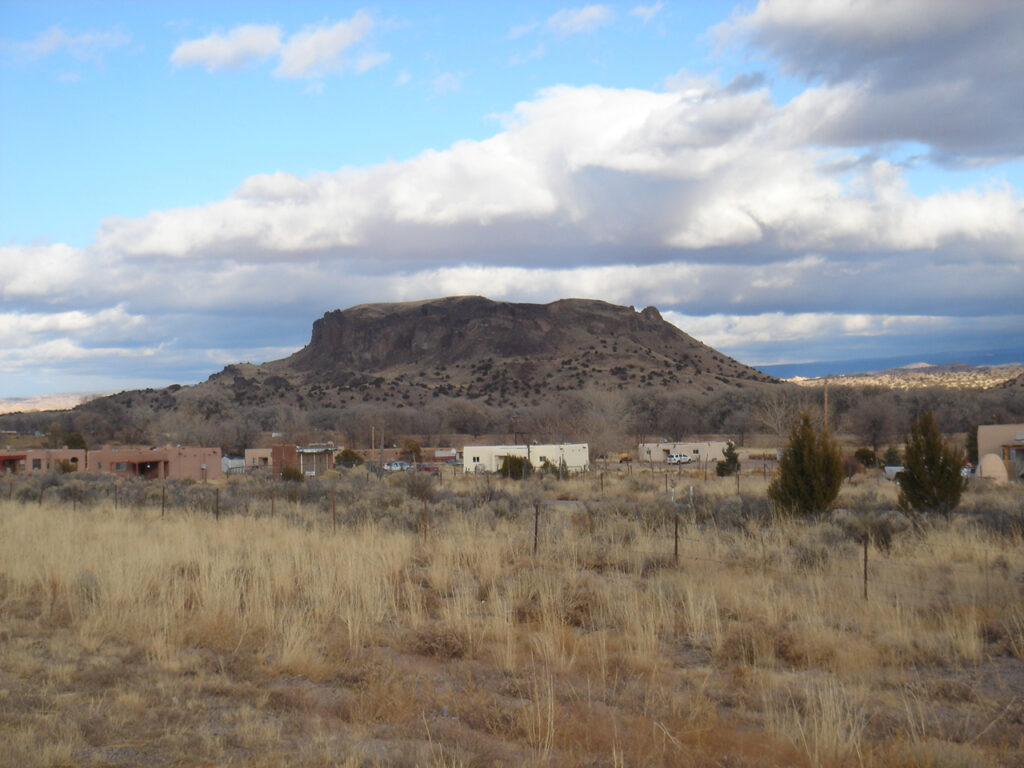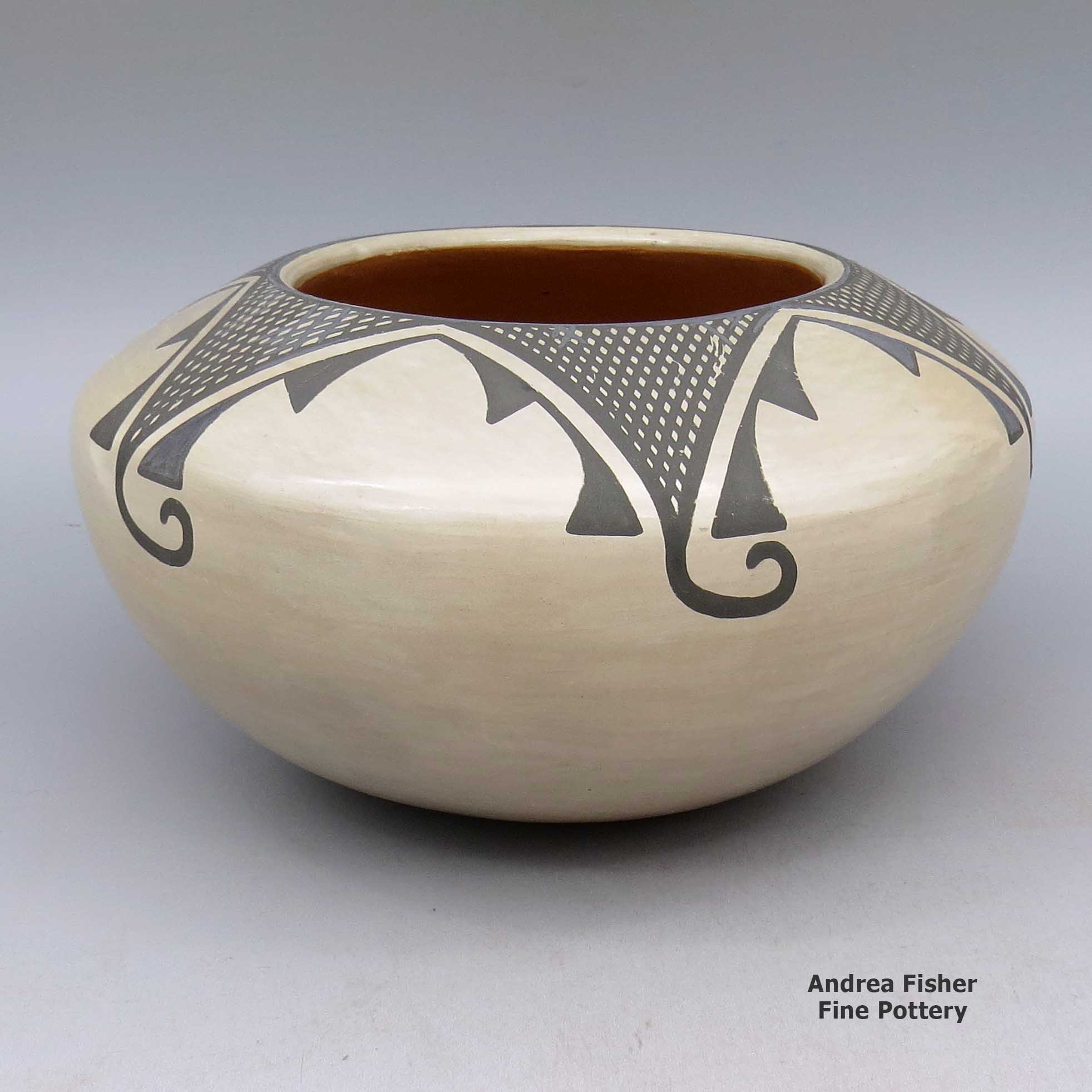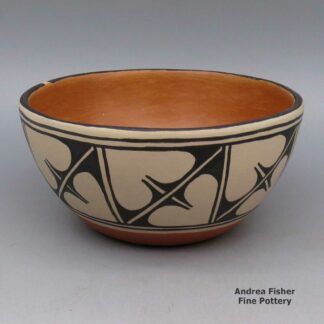| Dimensions | 8.5 × 8.5 × 4.75 in |
|---|---|
| Condition of Piece | Very good, some scratching on paint |
| Signature | Blue Corn San Ildefonso Pueblo |
Blue Corn, lksi2l293, Bowl with geometric design and micaceous slip
$2,800.00
A polychrome bowl with micaceous slip on inside and decorated on the outside with a geometric design
In stock
Brand
Blue Corn
Blue Corn made her first piece of pottery at the age of three. She said her grandmother told her when she was young, "Your hands were made for pottery." That was a prophetic statement because Blue Corn made pottery for nearly her entire life.
Blue Corn was born in that time when many Native American children were being educated in boarding schools. She was educated at the Santa Fe Indian School, about 25 miles from home. Both her parents died while she was away at school. Summers were spent in her grandmother's home until she had enough of school. Then she was sent to live with relatives in southern California.
For a while she worked as a maid in a Beverly Hills mansion. Then she returned to New Mexico and met Artillery Sergeant Santiago Calabazas. He, too, was an orphan and was educated in boarding schools. Neither of them had graduated high school. They fell in love but World War II was on. After the war he returned to Santo Domingo Pueblo and resumed his career as a silversmith. Then he and Blue Corn married. In keeping with Pueblo tradition he moved to her home at San Ildefonso.
In those years Blue Corn worked as a housekeeper for J. Robert Oppenheimer, the famous nuclear physicist who was the founder and first Director of Los Alamos National Laboratory. She began making pottery again after her first son, Joseph, was born.
Blue Corn was especially known for her polychrome designs on cream-colored jars and plates. She and Santiago spent several years experimenting with different techniques, forms, clays and colors.
Blue Corn produced a significant number of redware and blackware pieces through the years. By the late 1960s she was emerging as a leader in the revival of polychrome pottery. She was known for highly polished white, cream and buff slips, which she said she produced by polishing very slowly. She also selected subtle colors of clay with which to paint her designs.
Santiago passed away in 1972 and their son Joseph took his place in helping Blue Corn make her pottery.
Blue Corn was known for making jars, plates, wedding vases, oval blackware lidded boxes and black-on-black owl figures. Her favorite designs included feathers, rain clouds, turtles and the avanyu (the mythic Tewa water serpent).
She did demonstrations and exhibitions all around the country and participated in shows like the Santa Fe Indian Market and the New Mexico State Fair, earning major awards at both. In 1981 she was awarded the 8th Annual Governor's Award, the highest artistic honor awarded by the State of New Mexico.
When she died, Blue Corn had raised 10 children and they had given her 18 grandchildren and 10 great-grandchildren. She had also taught many people how to make pottery, including most of her own children. Some of them went on to become award-winning potters in their own right.
Some Exhibits that featured Blue Corn's work
- Gifts from the Community. Heard Museum West. April 12, 2008 - October 12, 2008
- Choices and Change: American Indian Artists in the Southwest. Heard Museum North. Scottsdale, AZ. 2007
- Home: Native Peoples in the Southwest. Heard Museum. Phoenix, AZ. 2005
- Breaking the Surface: Carved Pottery Techniques and Designs. Heard Museum. Phoenix, AZ. 2004
- Hold Everything! Masterworks of Pottery and Basketry from the Heard Museum. Heard Museum. Phoenix, AZ. 2001
- Images, Artists, Styles: Recent Acquisitions from the Heard Museum Collection. Heard Museum North. Scottsdale, AZ. 2001
- Lovena Ohl: An Eye for Art, A Heart for Artists. Heard Museum. Phoenix, AZ. 2000
- Legacy of Generations: Pottery by American Indian Women. Heard Museum. Phoenix, AZ. 1998
- Recent Acquisitions from the Herman and Claire Bloom Collection. Heard Museum. Phoenix, AZ 1997
- Lovena Ohl Gallery. Scottsdale, AZ. 1994
- Rain. Heard Museum. Phoenix, AZ. 1993
- Dancing Across Time: Indian Images of the Southwest. American Contemporary Arts. San Francisco, CA. 1995
- Blue Corn and Al Nez. Lovena Ohl Gallery. Scottsdale, AZ. 1991
- Al Nez, Norma Antone, Blue Corn and Elk Woman. Lovena Ohl Gallery. Scottsdale, AZ. 1990
- Seven Families in Pueblo Pottery. Simply Santa Fe. Santa Fe, NM. 1990
- 18th Anniversary Show. Pacific Western Traders. Folsom, CA. 1989
- Phil Poseyesva and Blue Corn. Lovena Ohl Gallery. Scottsdale, AZ. 1989
- Breaking the Surface: Carved Pottery Techniques and Designs. Heard Museum. Phoenix, AZ. 2004
- Indian Art for the Home. Lovena Ohl Gallery. Scottsdale, AZ. 1988
- San Ildefonso Pottery: Blue Corn. Heard Museum. Phoenix, AZ. 1988
- Al Nez and Blue Corn. Lovena Ohl Gallery. Scottsdale, AZ. 1987
- Mother Earth, Father Sky. University of Southern California. Idyllwild, CA. 1987
- 1987 Group Show. Lovena Ohl Gallery. Scottsdale, AZ.
- 1986 Group Show. Robert Dean Gallery. Scottsdale, AZ. Dennis Tewa, Michael Kabotie and Blue Corn. Lovena Ohl Gallery. Scottsdale, AZ. 1986
- Celebrate the Spirit. Felicita Foundation for the Arts. Mathes Cultural Center. Escondido, CA. 1985
- Art for Life. Scottsdale Center for the Arts. Scottsdale, AZ. 1983
- 1983 Group Show. Gallery 10. Scottsdale, AZ.
- Larry Grolsch, Blue Corn and Robert Redbird. Lovena Ohl Gallery. Scottsdale, AZ. 1982
- Seven Pueblo Potters. Lovena Ohl Gallery. Scottsdale, AZ. 1982
- 1982 Autumn Market. Pacific Western Traders. Folsom, CA.
- American Indian Pottery and Baskets: Art Deco Design. L'Omega Gallery. Kansas City, MO. 1981
- Art of the Southwest. Pacific Western Traders. Folsom, CA. 1980
- The Santa Fe Indian Market in Perspective. Wheelwright Museum of the American Indian. Santa Fe, New Mexico. August 1979 - September 24, 1979
- Images from the Earth. Institute of American Indian Arts. Santa Fe, NM. 1978
- Feature Artists for the 1977-1978 Season. Tanner's Indian Arts. Scottsdale, AZ. 1977
- Ceramics: New Mexico. University of New Mexico. Albuquerque, NM. 1974
- Eighth Scottsdale National Indian Arts Exhibition. Executive House. Scottsdale, AZ. 1969
- Seventh Scottsdale National Indian Arts Exhibition. Executive House. Scottsdale, AZ. 1968
Some Awards Blue Corn earned
- 1993 Santa Fe Indian Market. Class II - Pottery, Div. F - Traditional, Second Place; Div. E - Traditional, Second Place
- 1986 Santa Fe Indian Market. Class II - Pottery, Div. E - Traditional, Cat. 1107 - Plates, Third Place;
- Div. H - Non-traditional, Cat. 1309 - jewelry, First Place;
- Div. D - Traditional Pottery, Carved, Cat. 1006 - Plates, First Place - 1981 Eight Annual Governor's Award. Albuquerque, NM.
- 1978 Heard Museum Guild Indian Arts and Crafts Exhibit, Classification VII, Division C - Miniatures: Honorable Mention. Awarded for artwork: Polychrome bowl
- 1977 Heard Museum Guild Indian Arts and Crafts Exhibit. Heard Museum. Phoenix, AZ. Class V - Baskets, Cat. D - Other Traditional, First Place
- 1973 Heard Museum Guild Indian Arts and Crafts Exhibit, Classification XII - Pottery, Division A - Traditional shapes and designs: Second Place
- 1969 Eighth Scottsdale National Indian Arts Exhibition. Executive House. Scottsdale, AZ. Section B - Crafts. Classification VII - Pottery, Section 2 - New Mexico: Second Place
- 1968 Seventh Scottsdale National Indian Arts Exhibition. Executive House. Scottsdale, AZ. Section B - Crafts, Classification IX - Pottery, Division A - Traditional, Section 2 - New Mexico: First Place and Honorable Mention
A Short History of San Ildefonso Pueblo

San Ildefonso Pueblo is located about twenty miles northwest of Santa Fe, New Mexico, mostly on the eastern bank of the Rio Grande. Although their ancestry has been traced as far back as abandoned pueblos in the Mesa Verde area in southwestern Colorado, the most recent ancestral home of the people of San Ildefonso is in the area of Bandelier National Monument, the prehistoric village of Tsankawi in particular. The area of Tsankawi abuts today's reservation on its northwest side.
The San Ildefonso name was given to the village in 1617 when a mission church was established. Before then the village was called Powhoge, "where the water cuts through" (in Tewa). The village is at the northern end of the deep and narrow White Rock Canyon of the Rio Grande. Today's pueblo was established as long ago as the 1300s and when the Spanish arrived in 1540 they estimated the village population at about 2,000.
That first village mission was destroyed during the Pueblo Revolt of 1680 and when Don Diego de Vargas returned to reclaim the San Ildefonso area in 1694, he found virtually the entire tribe on top of nearby Black Mesa, along with almost all of the Northern Tewas from the various pueblos in Tewa Basin. After an extended siege, the Tewas and the Spanish negotiated a treaty and the people returned to their villages. However, the next 250 years were not good for any of them.
The Spanish swine flu pandemic of 1918 reduced San Ildefonso's population to about 90. The tribe's population has increased to more than 600 today but the only economic activity available for most on the pueblo involves the creation of art in one form or another. The only other jobs are off-pueblo. San Ildefonso's population is small compared to neighboring Santa Clara Pueblo, but the pueblo maintains its own religious traditions and ceremonial feast days.

Photo is in the public domain
About Bowls
The bowl is a basic utilitarian shape, a round container more wide than deep with a rim that is easy to pour or sip from without spilling the contents. A jar, on the other hand, tends to be more tall and less wide with a smaller opening. That makes the jar better for cooking or storage than for eating from. Among the Ancestral Puebloans both shapes were among their most common forms of pottery.
Most folks ate their meals as a broth with beans, squash, corn, whatever else might be in season and whatever meat was available. The whole village (or maybe just the family) might cook in common in a large ceramic jar, then serve the people in their individual bowls.
Bowls were such a central part of life back then that the people of the Classic Mimbres society even buried their dead with their individual bowls placed over their faces, with a "kill hole" in the bottom to let the spirit escape. Those bowls were almost always decorated on the interior (mostly black-on-white, color came into use a couple generations before the collapse of their society and abandonment of the area). They were seldom decorated on the exterior.
It has been conjectured that when the great migrations of the 11th, 12th, 13th and 14th centuries were happening, old societal structures had to change and communal feasting grew as a means to meet, greet, mingle with and merge newly arrived immigrants into an already established village. That process called for larger cooking vessels, larger serving vessels and larger eating bowls. It also brought about a convergence of techniques, styles, decorations and design palettes as the people in each locality adapted. Or didn't: the people in the Gallina Highlands were notorious for their refusal to adapt and modernize for several hundred years. They even enforced a No Man's Land between their territory and that of the Great Houses of Chaco Canyon, killing any and all foreign intruders. Eventually, they seem to have merged with the Towa as those people migrated from the Four Corners area to the southern Jemez Mountains.
Traditional bowls lost that societal importance when mass-produced cookware and dishware appeared. But, like most other Native American pottery in the last 150 years, market forces caused them to morph into artwork.
Bowls also have other uses. The Zias and the Santo Domingos are known for their large dough bowls, serving bowls, hair-washing bowls and smaller chili bowls. Historically, these utilitarian bowls have been decorated on their exteriors. More recently, they've been getting decorated on the interior, too.
The bowl has also morphed into other forms, like Marilyn Ray's Friendship Bowls with children, puppies, birds, lizards and turtles playing on and in them. Or Betty Manygoats' bowls encrusted with appliqués of horned toads or Reynaldo Quezada's large, glossy black corrugated bowls with custom ceramic black stands.
When it comes to low-shouldered but wide circumference ceramic pieces (such as many Sikyátki-Revival and Hawikuh-Revival pieces are), are those jars or bowls? Conjecture is that the shape allows two hands to hold the piece securely by the solid body while tipping it up to sip or eat from the narrower opening. That narrower opening, though, is what makes it a jar. The decorations on it indicate that it is more likely a serving vessel than a cooking vessel.
This is where our hindsight gets fuzzy. In the days of Sikyátki, those potters used lignite coal to fire their pieces. That coal made a hotter fire than wood or manure (which wasn't available until the Spanish brought it). That hotter fire required different formulations of temper-to-clay and mineral paints. Those pieces were perhaps more solid and liquid resistant than most modern Hopi pottery is: many Sikyátki pieces survived intact after being slowly buried in the sand and exposed to the desert elements for hundreds of years. Many others were broken but were relatively easy to reassemble as their constituent pieces were found all in one spot and they survived the elements. Today's pottery, made the traditional way, wouldn't survive like that. But that ancient pottery might have been solid enough to be used for cooking purposes, back in the day.
About Geometric Designs
"Geometric design" is a catch-all term. Yes, we use it to denote some kind of geometric design but that can include everything from symbols, icons and designs from ancient rock art to lace and calico patterns imported by early European pioneers to geometric patterns from digital computer art. In some pueblos, the symbols and patterns denoting mountains, forest, wildlife, birds and other elements sometimes look more like computer art that has little-to-no resemblance to what we have been told they symbolize. Some are built-up layers of patterns, too, each with its own meaning.
"Checkerboard" is a geometric design but a simple black-and-white checkerboard can be interpreted as clouds or stars in the sky, a stormy night, falling rain or snow, corn in the field, kernels of corn on the cob and a host of other things. It all depends on the context it is used in, and it can have several meanings in that context at the same time. Depending on how the colored squares are filled in, various basket weave patterns can easily be made, too.
"Cuadrillos" is a term from Mata Ortiz. It denotes a checkerboard-like design using tiny squares filled in with paints to construct larger patterns.
"Kiva step" is a stepped geometric design pattern denoting a path into the spiritual dimension of the kiva. "Spiral mesa" is a similar pattern, although easily interpreted with other meanings, too. The Dineh have a similar "cloud terrace" pattern.
That said, "geometric designs" proliferated on Puebloan pottery after the Spanish, Mexican and American settlers arrived with their European-made (or influenced) fabrics and ceramics. The newcomers' dinner dishes and printed fabrics contributed much material to the pueblo potters design palette, so much and for so long that many of those imported designs and patterns are considered "traditional" now.
Ramona Gonzales Family Tree - San Ildefonso Pueblo
Disclaimer: This "family tree" is a best effort on our part to determine who the potters are in this family and arrange them in a generational order. The general information available is questionable so we have tried to show each of these diagrams to living members of each family to get their input and approval, too. This diagram is subject to change should we get better info.
-
Ramona Sanchez Gonzales (1885-), second wife of Juan Gonzales (painter)
- Rose (Cata) Gonzales (daughter-in-law)(1900-1989)(San Juan) & Robert Gonzales (1900-1935)
- (Johnnie) Tse-Pe (Gonzales)(1940-2000) & Dora Tse-Pe (Gachupin, first wife, Zia, 1939-)
- Andrea Tse Pe (1975-)
- Candace Tse-Pe (1968-)
- Gerri Tse-Pe (1963-)
- Irene Tse-Pe (1961-)
- Jennifer Tse-Pe (1966-1983)
- (Johnnie) Tse-Pe (1940-2000) & Jennifer Tse Pe (Sisneros - second wife, Santa Clara)
- Marie Gonzales-Kailahi & James Kailahi
- (Johnnie) Tse-Pe (Gonzales)(1940-2000) & Dora Tse-Pe (Gachupin, first wife, Zia, 1939-)
- Blue Corn (Crucita Gonzales Calabaza)(1921-1999)(step-daughter of Ramona) & Santiago Calabaza (Santo Domingo) (d. 1972)
- Heishi Flower (Diane Calabaza-Jenkins) (1955-)
- Joseph Calabaza (Tha Mo Thay)
- Elliott Calabaza
- Lucille Calabaza-King
- Nancy Calabaza
- Sophia Calabaza
- Stacey Calabaza
- Krieg Kalavaza
- Vera Solomon (Laguna)
Rose' students: - Juanita Gonzales (1909-1988) & Louis Wo-Peen Gonzales (brother of Rose Gonzales husband)
- Adelphia Martinez (1935- )
- Lorenzo Gonzales (1922-1995)(adopted by Louis & Juanita) & Delores Naquayoma (Hopi/Winnebago)
- Jeanne M. Gonzales (1959-)
- John Gonzales (1955-)
- Laurencita Gonzales
- Linda Gonzales
- Marie Ann Gonzales
- Raymond Gonzales
- Robert Gonzales (1947-) & Barbara Tahn-Moo-Whe Gonzales (1947-)
- Aaron Gonzales (1971-)
- Brandon Gonzales (1983-)
- Cavan Gonzales (1970-)
- Derek Gonzales (1986-)
- Oqwa Pi (Abel Sanchez)(1899-1971) & Tomasena Cata Sanchez (Rose' sister) (1903-1985)
- Skipped generation
- Russell Sanchez (1966-)
- Skipped generation





